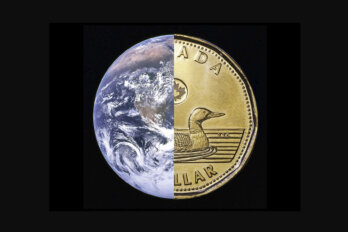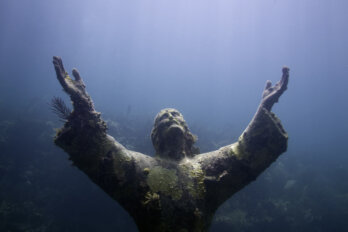Search for “Paul Nicklen” on YouTube and you’ll find one of the most incredible videos you will ever see. The top result, “Face-Off With a Deadly Predator,” recounts the wildlife photographer’s harrowing encounter with a thirteen-foot-long Antarctic leopard seal. After an initial threat display — the predator spread her jaws wide around his head and camera — she took it upon herself to try feeding him a diet of penguins. He never stopped shooting, and came away with stunning proof that the species is less violent and hostile than textbooks suggest.
Nicklen has spent much of his life at the extremes of human existence. Born in Saskatchewan, at age four he moved with his parents and brother to Iqaluit, now the capital of Nunavut, and then Kimmirut, a distant northern community with fewer than 200 Inuit residents. Growing up in the rugged Arctic climate instilled a passion for the environment that has directed his career. As a student at the University of Victoria, he stopped studying for his final exams to sketch out a path towards becoming a photographer for National Geographic — and then walked the line. He’s since published ten stories in the magazine, which displays his photos to a worldwide audience of 40 million readers.
Nicklen’s recent book, Polar Obsession, documents the past decade of his craft. He spoke to walrusmagazine.com on the phone from his home in Whitehorse.
You are uniquely positioned to do this work in a way that 99.9 percent of us are not. Spending part of your childhood in a remote Inuit settlement must have planted an important seed.
I was always coming home with frostbite or a new pet that I’d found, a new story of being outside for twenty-four hours. When my parents informed me that we were moving from Kimmirut back to Iqaluit, I remember that specific moment: where I was standing, how depressed I was, how angry I was. It felt like my life had been stolen from me.
Iqaluit is 60 percent Inuit, but it’s got television and the telephone and all these other distractions that keep people busy and indoors. My whole world is being outside. I love to feed all my senses. I was out this morning hiking in the hills. I was standing on a ridge with snow pounding down; I closed my eyes and I could have been anywhere in the Arctic. It’s almost deafening silence. I could hear the snow pattering against my jacket as it fell.
Who engendered the survival skills that carry you through your work?
I looked up to my dad and his skills on the land; the way we could pack up and go camping for two weeks out on the sea ice was really neat. It was [valuable] being around the Inuit hunters too, and seeing how calm and patient they were. If the weather was bad, they would sit down for a day or two days or a whole week , waiting to catch one animal to feed their families. A lot of the patience I now have for photography comes from witnessing the hunters then.
What about professional influences? Who helped you become a visual storyteller?
After being a photographer for six years, I’d done a book, I’d been published in magazines around the world, I’d photographed almost every species in the Arctic. I still did not know how to tell a story. It leaves you feeling empty to have a bunch of pretty pictures and to be making money off them. That doesn’t inspire you.
Finally I met Flip Nicklin in Churchill, Manitoba. He took me under his wing and mentored me. He kept telling me about the importance of shooting journalistic stories, but I couldn’t get the concept. It took two years of him beating that into my head. Then I met Joel Sartore, who is another influential photographer. Flip introduced us on an assignment. They’re both very giving men. I meet so many photographers now who won’t share with each other. Generally, they’re only pretty-picture photographers when they’re that competitive. It’s the people who believe in telling important stories who share unconditionally.
Polar Obsession represents the last ten years of your work, focused on explorations of the Arctic and Antarctica. Each chapter is dominated by the pursuit of one creature, like the bowhead whale, the narwhal, or the polar bear. Through these stories, you’re also relating information about bearded seals, walruses, gulls —
I’m trying to make people realize that all these ecosystems are connected. If you tell someone in New York that we’re losing ice in the Arctic or Antarctica, I don’t think they really care. But if you say, “In the next hundred years, polar bears may become extinct because of the lives we’re living in the south,” they’re going to care a lot more. If we lose ice, we lose polar bears. It’s as simple as that.
In the book’s introduction, you write, “It is now my mission to bring the rare, remote, and threatened to caring people who can enjoy and help protect these lands and creatures.” What do you reckon is the toughest part of that job?
I do a lot of lecturing around the world: Europe, the U.S. and Canada, wherever. You realize that people are extremely busy. The hardest part is getting through to them. There’s so much guilt about what’s happening on the planet right now, the easiest thing is to push it aside. If there’s a catastrophic event like [a 7.0 earthquake in] Haiti, then the world can come together and give money and care — but it’s a short-term fix for a much bigger problem.
Inuit hunters are known for sharp observational abilities. From your biology training, is the methodology radically different?
The Inuit are incredible biologists. They get how the ecosystem is linked together. They’re on the front lines every day; they’re not in offices writing scientific papers. When they shoot a seal, they can realize instantly if she’s pregnant, and are able to cut her open and save the pup. Then they give it to their kids as a pet for a while.
It’s funny, you read the scientific literature and it says, “No female narwhals have tusks.” But I’ve been out with the hunters, and they say, “Of course they have tusks. It may be very few of them, but some do.” I tell scientists this, but they say, “Well, we don’t have proof of that.”
You are passionate about scuba diving; you’ve said you feel most comfortable beneath ten feet of sea ice. Do many Inuits have interest in getting down in the water themselves?
They’re terrified of water, yet they live on this frozen film on top of the ocean. They’re falling through the ice all the time; they’re sinking snowmobiles. Most of them can’t swim. In their small, traditional communities, there aren’t any pools. The ocean water is near freezing year round, so they’re not going to go in it. But they do daring things out on the ice. It will form overnight and it will be half an inch thick; it’ll be kind of slushy and supple and it will bend — and they’ll be out there trying to retrieve a walrus.
I always have [Inuit] people asking if they can try my dry suit. I’ve only had a couple takers. One gentleman, I got him into a melt-water channel that was about a foot deep. I pushed him out slowly, and held on to him the whole time. I got him so he could peek over the 2,000–foot edge of the ocean. Even though his body was still on the shelf, he started to panic so badly that he tried to walk on the water with his hands; he tried to climb into the air. I had to lift him out completely and calm him down. All the other Inuit were in awe that he was so brave… There is one hunter by the name of Andrew Taqtu. Flip Nicklin taught him how to dive and he is as fearless and as good a diver as they get.
If I have my dry suit on when they’re hunting narwhals and seals and different things, they’ll often ask me to go retrieve an animal they can’t reach. I’ll have to swim out and get it for them and tow it back so they can eat.
The YouTube clip of you photographing a leopard seal in Antarctica has attracted nearly two million views. In that instance — unlike helping the Inuit hunters — you declined to engage her. Why did you refuse her gift of the penguins?
Because of two things. By law, in Antarctica, you’re not supposed to alter an animal’s behaviour. I put myself in the water, but it was up to her to come to me. I was trying to be a fly on the wall, but obviously I was at the centre of that encounter. If I took a penguin, who knows what might have happened? The dynamic could change. She might think, “Okay, you’ve been fed, I’m going to leave now.”
Also, my assistant Göran told me that he once had a leopard seal throw a live penguin into his Zodiac. He took off with the penguin; he was going to put it back on an ice floe. The seal became agitated and chased him down. It got quite aggressive.
As a biologist, as an ecologist, and as a photographer, I’ve been slowly trying to figure out that encounter. I can draw conclusions now because I’ve had a couple years to think about what happened. But at the time, you’re sitting there with your jaw hanging open and tears in your eyes and you’re just shooting.
Many photographers who work for prolonged stints in hot zones of war reach the point where they won’t expose themselves to the danger of it anymore. Given your specialty with extreme cold and wet conditions, do you anticipate a turn in your ability to do this work?
I’m young, I’m fit. I can keep going. It’s just mentally — once you’ve had five or six or seven or eight near-death experiences like I have — you start to believe that you’re bulletproof. I imagine it’s similar to what war photographers experience. Bullets are whizzing over their heads, but they didn’t get shot yesterday, so maybe they stand up a little higher to get their next picture.
Right now I’m running and skiing and lifting weights to get ready, because every time I go in the field it’s like going into battle. You’re diving under the ice; it’s very strenuous. My problem is that sometimes I’m too fearless. I get off on close encounters; I like the adrenaline of getting in the water with a leopard seal or a walrus. In November 2008 I was attacked by an 8,000-pound bull elephant seal. It was trying to crush me in shallow ocean waters. That’s the first time in my career when I thought, “So this is how I’m going to die.”
I need to take it easy. If I get killed by a seal, after everything I’ve ever done to show these animals as peaceful, gentle giants, I’ll have done a huge disservice to the animals I’m trying to help. It’s my duty to stay alive and not get hurt. At National Geographic they call me the street photographer who works underwater.





